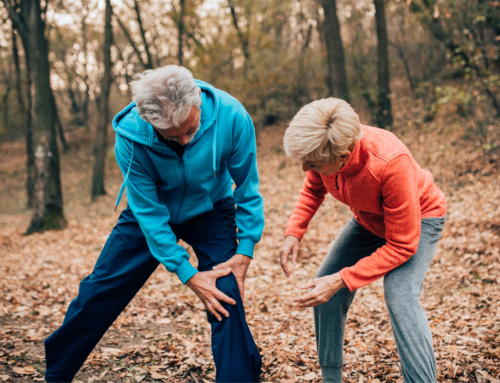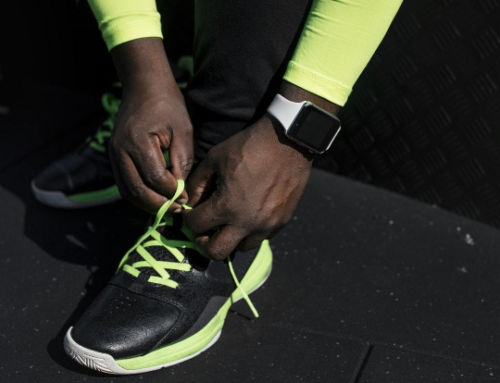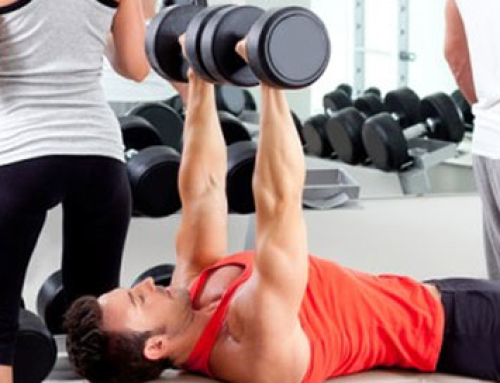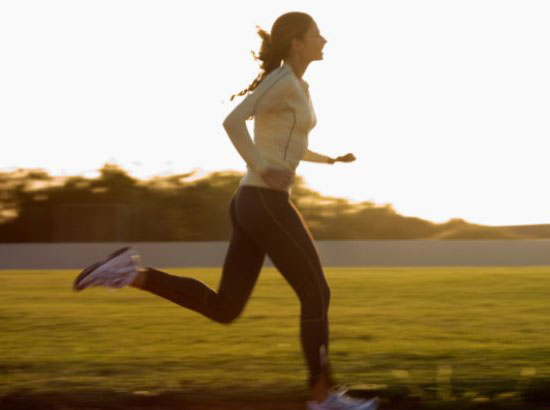Not only will High-Intensity Interval Training (HIIT) add variety to your exercise plan, it can take your fitness to the next level. HIIT is a cardiopulmonary training technique that alternates brief speed and recovery intervals to increase the overall intensity of your workout. HIIT is used by athletes and everyday exercise enthusiasts to reach performance goals and enhance fitness and well-being.
What Is HIIT?
High Intensity Interval Training involves alternating between very intense bouts of exercise and low intensity exercise. For example, sprinting for 30 seconds, then walking for 60 seconds is high intensity interval training. HIIT can be used both anaerobically (in the gym with weights) and aerobically with cardio.
How does it work?
Most endurance workouts, such as walking, running, or stair-climbing—are performed at a moderate intensity, or an exertion level of 5-6 on a scale of 0-10. High-intensity intervals are done at an exertion level of 7 or higher, and are typically sustained for 30 seconds to 3 minutes, although they can be as short as 8-10 seconds or as long as 5 minutes; the higher the intensity, the shorter the speed interval. Recovery intervals are equal to or longer than the speed intervals.
High-intensity interval training is done at a submaximal level; around 80-95% of maximal aerobic capacity. Sprint interval training (SIT) is a type of high-intensity interval training that pushes beyond this level to 100% or more of maximal aerobic capacity, or an exertion level of 10 (maximum level of exertion).
Benefits of HIIT
1. Efficient:
Super-efficient HIIT is the ideal workout for a busy schedule—whether you want to squeeze in a workout during your lunch break or to get in shape for a fast-approaching event. Research shows you can achieve more progress in a mere 15 minutes of interval training (done three times a week) than the woman jogging on the treadmill for an hour. (A 10-minute fat-blasting cardio routine that burns more calories than a half hour on the treadmill!) And according to a 2011 study presented at the American College of Sports Medicine Annual Meeting, just 2 weeks of high-intensity intervals improves your aerobic capacity as much as 6 to 8 weeks of endurance training.
 2. Burn More Fat:
2. Burn More Fat:
Not only do you burn more calories during a HIIT workout, but the effect of all that intense exertion kicks your body’s repair cycle into hyperdrive. That means you burn more fat and calories in the 24 hours after a HIIT workout than you do after, say, a steady-pace run.
3. Healthier Heart:
Most people aren’t used to pushing into the anaerobic zone (that lovely place where you can’t breathe and you feel like your heart is trying to jump out of your chest). But in this case, extreme training and pushing our bodies to maximum exertion can produce extreme results. One 2006 study found that after 8 weeks of doing HIIT workouts, subjects could bicycle twice as long as they could before the study, while maintaining the same pace.
4. No Equipment Necessary:
Running, biking, jump roping, and rowing all work great for HIIT, but you don’t need any equipment to get it done. High knees, fast feet, or anything plyometric like jumping lunges work just as well to get your heart rate up fast. In fact, some equipment like dumbbells can make HIIT less effective because you want the focus to be on pushing your heart to its max, not your biceps.
5. Lose Weight, Not Muscle:
Anyone who has been on a diet knows that it’s hard to not lose muscle mass along with fat. While steady state cardio seems to encourage muscle loss, studies show that both weight training and HIIT workouts allow dieters to preserve their hard-earned muscles while ensuring most of the weight lost comes from fat stores. Win/win!
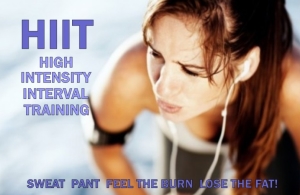 6. Increase Metabolism:
6. Increase Metabolism:
In addition to increased fat burning and more muscle preservation, HIIT stimulates production of your human growth hormone (HGH) by up to 450 percent during the 24 hours after you finish your workout. This is great news since HGH is not only responsible for increased caloric burn but also slows down the aging process, making you younger both inside and out!
7. Do It Anywhere:
You can do it in a boat, you can do it with a goat. You can do it here or there, you can do it anywhere! Dr. Seuss would have loved HIIT. Since it’s such a simple concept—go at maximum effort for a short period of time followed by a recovery period and repeat—you can adapt it to whatever time and space constraints you have.
8. Challenging:
This is not a workout you can do while reading a magazine or chatting with your friend. Because it’s so short, you will be working hard the whole time. The trade-off is this format offers seasoned exercisers a new challenge and new exercisers a quick way to see results. You may be in pain, you may be sucking wind, but you definitely won’t be bored!
Recovery after HIIT
Have you ever completed a particularly difficult HIIT session and found your muscles to be a little shaky afterwards (more common when weights or strength training is incorporated)? This is when you know you’ve definitely depleted your glycogen stores, which is the primary fuel your muscles use during a workout). That’s good, it is exactly what we want!
But, how do we restore those levels? Well, your body will eventually do this on its own but if you want to speed up the process, then you need to focus on consuming the right ingredients within 20 minutes of your completed exercise. The body’s ability to turn carbs into useful glycogen declines in the hours following your workout. This is why many people choose to carb-load immediately following the completion of their workout.
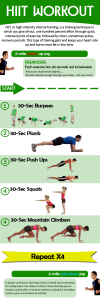 Not Just For Youngsters
Not Just For Youngsters
Scientific studies show that staying physically active and exercising regularly can help prevent or delay many diseases and disabilities. Scientists find that even moderate exercise and physical activity can improve the health of people who are frail, or who have diseases that accompany aging.
Exercise and physical activity are among the healthiest things you can do for yourself, but some older adults are reluctant to exercise. Some are afraid that exercise will be too strenuous, or that physical activity will harm them. Yet, studies show that exercise is safe for people of all age groups and that older adults hurt their health far more by not exercising than by exercising.
An inactive lifestyle can cause older people to lose ground in four areas that are important for staying healthy and independent: strength, balance, flexibility and endurance. But research suggests that exercise and physical activity can help older people maintain or partly restore these four areas.
Growing older doesn’t mean people have to lose their strength or their ability to do everyday tasks. Exercise can help older adults feel better and enjoy life more, even those who think they’re too old or too out of shape. Increasing strength and endurance make it easier to climb stairs and carry groceries. Improving balance helps prevent falls. Being more flexible may speed recovery from injuries. If you make exercise a regular part of your daily routine, it will have a positive impact on your quality of life as you get older.
Sample Workout For Beginners
Total Workout Time: 10 Minutes
Exercise One: Cycling (High Intervals performed cycling at maximum intensity, low intervals done pedaling at moderate speed)
- Interval One: 30 Seconds at 50 Percent Intensity
- Interval Two: 15 Seconds at 90 Percent Intensity
- Interval Three: 30 Seconds at 50 Percent Intensity
- Interval Four: 20 Seconds at 95 percent intensity
- Interval Five: 30 Seconds at 50 Percent Intensity
- Interval Six: 20 Seconds at 100 Percent Intensity
- Interval Seven: 1 Minute at 50 Percent Intensity
- Interval Eight: 30 Seconds at 100 Percent Intensity
Exercise Two: Sprints (High intervals done performing sprints at 100 percent maximum intensity, low intervals done performing a light jog)
- Interval One: 20 Seconds Sprints done at 100 percent maximum intensity
- Interval Two: 40 Seconds light jog at 50 percent intensity
- Interval three: 30 Seconds sprints done at 100 percent maximum intensity
- Interval Four: 1 minute light jog at 50 percent intensity
- Interval five: 30 seconds sprints done at 100 percent maximum intensity
- Interval Six: 1 minute light jog at 50 percent intensity
- Interval Seven: 45 Seconds sprint at 100 percent maximum intensity
- Interval eight: 45 seconds light jog at 50 percent intensity
- Interval nine: 1 Minute sprints done at 90 percent intensity
- Interval Ten: 1 minute light jog at 50 percent intensity
These are just a few HIIT workouts you can perform at the various fitness levels. The key to HIIT success is to constantly change up your routine and come up with new exercises and interval paces. You have a lot of potential for variety with HIIT as you can change the exercise, length of interval, and rest time between intervals. Make sure you are logging your HIIT workouts so you can constantly add variety and increase the intensity. Most importantly, have some fun with your HIIT routine.



